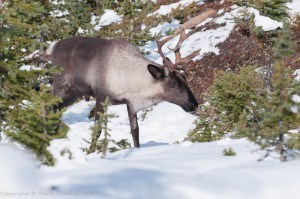
Jasper’s caribou herds are declining in size.
Last month, Parks Canada employees did their annual count of the four herds that call the park home and found that, once again, there are fewer caribou than last year.
Parks estimates that the A La Peche herd lost about 25 members, and now sits at around 100 animals. The other significantly-sized herd, the Tonquin, remained stable at 37.
The already tiny Brazeau herd lost half its members in what was almost certainly an avalanche, and now there are only eight of the 15 left. Even the struggling Maligne herd lost a member, leaving only five caribou remaining in that group.
In a presentation last month, John Wilmshurst explained that Jasper’s caribou population has been struggling for years, due to changes in predator/prey dynamics, increased human disturbance, habitat loss, predator access and the small population effect—the tendency for small caribou populations to continue declining.
During the Nov. 13 Wild Jasper talk at the Legion, Parks Canada’s Shelley Bird explained that in the wild, once an animal’s population drops below a certain number, it’s difficult for it to grow anymore.
She said right now the Tonquin herd is right on that line; it’s possible its numbers could bounce back, but if the herd shrinks any more that likely won’t happen.
Smaller herds, however, won’t be able to grow without help. Since there are so few animals left in both the Maligne and Brazeau herds, a natural disaster like an avalanche could wipe them out entirely.
“When you get herds that small, those events have a lot more impact,” said Bird.
While nothing is confirmed yet, Bird said, Parks Canada is trying to set up a captive breeding program to help bolster Jasper’s caribou populations.
“The goal is to keep these animals on the landscape, and eventually add more animals to [the herd],” she said.
Joining Bird for this month’s Wild Jasper presentation, was a pair of reindeer herders from Scotland.
Reindeer are the same species as caribou, but the two animals aren't exactly the same. The major difference between the them is that centuries ago reindeer were domesticated, while their Canadian cousins stayed wild.
Jack Ward and fellow herder Anna Jemmett live among their reindeer and are in close contact with them daily. Each of their herd’s 150 animals is completely tame, has a name, and regularly interacts with guests.
They live mostly on a 1,000-acre enclosure, but since none of their natural predators exist in Scotland any longer, they are often released into the hills to graze.
The staff at the Cairngorm Reindeer Centre, where Ward and Jemmett work, diligently monitors the herd’s population, using selective breeding to carefully control its population and keep its genetics strong.
“It’s much more hands-on in Scotland,” Jemmett explained.
Because they are so well-suited to cold climates, reindeer have been herded for centuries by tribes in arctic regions of Europe and Russia, who used them for their meat, hides, milk and as labour animals.
“They’re the farm animals of the north,” Ward explained.
Trevor Nichols
[email protected]

